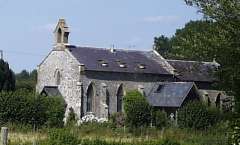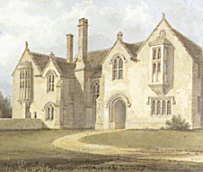
Send contributions, additions and corrections and report faulty links!
Please use this blank formating file for additions and corrections in HTML and copy it into your e-mail!
If you want your entire peidgree to be posted in the Internet, please use this free blank table pedigree form and attach it to an e-mail to the author of this site!
Lu17 William Ludlow
William Ludlow or Ludstrow (Lu17) of Hill Devrill, Wilts, was the son of
William
de Ludlow (Lu18) b.1390 and grandson of Robert
de Ludelowe (Lu19) and great grandson of Lawrence
de Ludelowe (Lu20) b. 1330 and 2nd great grandson of William
de Ludelowe (Lu21) b. 2 March 1301 and 3rd reat grandson of Lawrence
de Ludelowe
Born: 1397
Married: Margaret Rymer, b. c. 1410 dau. and heiress of William Rymer
and ? Warnell (Warmwell) daughter of William Warmwell and Johanna.
Died: 23 Dec. 1478 aged 81
Buried: at St. Thomas churchyard, Salisbury, Wilts.
He was a bouteiller (also called Sarjeant of the cellar) to King Henry
IV, V and VI. He was one of several in the royal household who became sheriffs.
He was sheriff in Shropshire, along with William Beuamont in Wiltshire.
He was Gauger in London from 1437 to 50 and in Hull from 1443 to
50. He became MP for Ludgershall in Wiltshire and later for Saqalisbury.
It appears from a MS. formerly preserved at Great Chalfield, that William
Ludlow, Lord of Hill Deverill, Boteler to King Henry IV. and King Henry
V. and VI., M.P. for Ludgershall, bore these Arms - Argent, a chevron between
three marten’s heads erased, sable, and that he was buried in St. Thomas's
Church in Salisbury, under a marble tomb, on the north side of the high
altar; the south side of an aisle he new ceiled and painted, and set with
escutcheons of his own arms and those of his wife. William Ludlow married
Margaret, daughter and heiress of William Rymer, and by her had a son,
John, and four daughters, the youngest of whom, named Margaret, married
Thomas Trapnel, or Tropenell, the projector of Great Chalfield Manor-house,
and whose noble altar-tomb, described by Aubrey, is still in the Tropenell
Chapel in Cersham Church. This tomb, with details, is engraved in Walker’s.”History
of Chalfield." |
 Hill Deverill Chapel - The Assumption of the Virgin Mary
Hill Deverill Chapel - The Assumption of the Virgin Mary
The Church of the Assumption of the Virgin Mary at Hill Deverill was
closed as redundant in 1984. It is situated on the main road and the view
through the lytch-gate is quite evocative. Since the old church is now
a private house, it's not possible to tramp around the place, but there's
a view of the building from the next side-road to the south.
The altar tomb at Kingston Deverill was moved from the Church of the
Assumption when it was closed. It is emblazoned with three medieval shields
which display the honours of the three families created by the marriages
of William Ludstrow with Margaret Rymer, Jack Ludlow with Philippa Bulstrode,
and his great great grandson William Ludlow with Jane Moore. From these
origins was descended Lieutenant General Edmund Ludlow, a Cromwellian soldier,
who was one of the signatories to the death warrant of King Charles I.
|
| Children:
(Lu16) John Ludlow
( Lu16-2) Margaret Ludlow - (? Thomas Tropenell*, son of Harry Tropenell
and Edith Roche) bur. at Corsam Church.
(Lu16-3) Joan Ludlow - m. 1st John Norwood.
2nd Thomas Ringwood of Southampton, son of Thomas Ringwood and Isabel
Feteplace.
(Lu16-4). Mary Ludlow, m William Sandes (Sonders)
(Lu16-5) Margery Ludlow - m. William Earle
(Lu16-6). Johanna Ludlow, m Robert Dynelly.
* Thomas Trapnel was the builder of Great Chalfield Manor.

Great Chalfield

Great Chalfield Manor House
|
Great Chalfield Manor was rebuilt between 1465 - 85 on the site of
an earlier fortified house.
The builder was Thomas Tropnell a wealthy Wiltshire landowner and businessman.
He made his fortune in the Wars of the Roses when the new middle class
became prosperous after the collapse of the old feudal nobility.
It was a period when no one could feel secure and the domestic yellow-stone
building was constructed around a central courtyard and approached through
a defensible gatehouse. The property formed a neat complex with the
manor house, farm buildings and parish church encircled by a curtain wall
and surrounded by a narrow moat.
No trace of the defensive walls and bastions of the older house remain
but the moat still has to be crossed to reach the outer courtyard.
From here an archway leads into the forecourt and the house.
The architectural composition of the house was exceptionally balanced
for the 15th century. The conventional medieval great hall, two storeys
high and lit from both sides, is flanked by two gabled wings with elaborate
oriel windows. The exterior is remarkable for the fine detail of
the stone mullioned windows, gables, arches and buttresses. The gable
ends have intricately carved stone figures of griffins and soldiers in
15th century armour which give the house a light-hearted appearance.
Although modest in scale, the building is perfectly proportioned and
the yellow-grey Corsham stone greatly adds to its charm.
The north, or main, front is much as Tropnell left it in 1480.
The south front was carefully restored and the south wing added in about
1910. The west wing was originally a farm building and facing
it across the courtyard is the tiny 14th or 15th century church.
The south chapel of the church was rebuilt by Tropnell and he added the
little projecting bellcote with a crocketed octagonal spire.
The interior plan of the house follows a late medieval pattern.
The porch leads directly into the finely-timbered great hall which is screened
at one end from the pantry and kitchen beyond and the bed-chamber that
lies above it. A rare feature for this period is the separate dining
room beyond the screens between the hall and the kitchens. This room
contains a mural portrait of Tropnell. At the other end of the great
hall a spiral staircase leads to the solar. Here unusual squints
in the form of hollow masks enabled the ladies to look down on the proceedings
in the hall.
Great Chalfield Manor has a well documented history.
The estate was recorded in the Domesday Book as the property of Ernulf
de Hesding, Comte de Perche. The property was owned by various branches
of the Percy family until the 16th century. In the Civil War Chalfield
was garrisoned by Parliamentary troops between 1644 - 46 and withstood
a short siege. The 1st Duke of Kington acquired the estate when he
married an heiress but it was sold by his son in 1770. The property
then remained in the hands of the Neale family until 1878 when it was acquired
by the Fuller family.
The appearance of Great Chalfield Manor today reflects the restoration
carried out between 1905 - 12 for Major R. Fuller by Sir Harold Brakspear.
This followed two centuries of neglect when the east wing was demolished
and the south wing also disappeared. To create his sympathetic reconstruction
Sir Harold worked from drawings made by Pugin's pupil Thomas Larken Walker
in 1836 when the building was still in its original state. At the
same time the gardens were restored by the Fuller family.
In 1947 Great Chalfield Manor was presented to the National Trust but
members of the Fuller family still live in the house and manage the property.
After the restoration Great Chalfield Manor took on a new lease of life.
Set close to the river Avon in placid open countryside, the house is once
again at the centre of a agricultural estate with home farms, labourer's
cottages, woodland and its own parish church.
The land is worked today as it has been for over 900 years and boundaries
and field names are still as they were shown on a map of 1794.
|
Source:
Robin Ludlow's Research
http://www.smokykin.com/
http://www.pd49.dial.pipex.com/places/deverill/deverill.htm
http://homepages.rootsweb.ancestry.com/~sam/ludlow.html
Ralph A.Griffiths, The Reign of Henry VI
EYRE OF WILTS
Humphrey Le Heyr, of Bromham, Wilts, he was a Crusader, and accompanied
Richard I. to the Holy Land. He married Gallicia, and her name appears
in an undated deed, probably in the reign of Henry 3rd, granting to her
son, Nicholas, some land. To this deed Richard of Bridwilston, Roger Le
Blount, and William Le Blount were witnesses.
Humphrey Le Heyr had by his wife two sons.
Galfridus Le Heyr, of Bromham, who was alive in the 3rd year of Edward
I.
Nicholas Le Heyr.
Galfridus granted to his brother, Nicholas, certain possessions to which
were attached conditions of homage and service.
Galfridus Le Heyr had a son, Galfridus Le Heyr, of Bromham, who was
living in the 15th year of Edward II.
He left issue.
Stephen Eyre.
Simon Eyre.
The eldest line of the family from Stephen Eyre continued to live at
Bromham, and are recorded in the visitation of 1623, but they appear to
have gone down in wealth and position, and are now supposed to be extinct.
Simon Eyre married Eleanor, the dr. and heiress of John Crooke, of Urchfont,
in the County of Wilts, and according to the visitations he had his seat
at Wedhampton, in the Parish of Urchfont.
He recovered seisen of his lands in Urchfont by the name of John Le
Eyr, in the reign of Edward II.
He left issue one son.
Simon Eyre, of Wedhampton, who is mentioned in the list of adherents
in Wilts to King Henry VI. in the Wars of the Roses, he left a son, Thomas
Eyre, of Wedhampton and Northcombe, who had issue, William Eyre, of Wedhampton
and Northcombe, who married Julia or Juliana Cockerell, and had two sons.
William Eyre, who was elected Prior of the Canons of St. Augustine,
Christchurch, Hants, in 1502. He died in 1520, and was buried behind the
high altar of the Priory Church, under a flat stone (which is still legible),
with the following inscription:
"Tumba Domini Wilhelmi Eyre. Vicessimi Quinte Prioris Rujns Ecclesiæ
qui obiit tertio die decembris anno domini Milessimo CCCCC et XX, Hujus
anime propitietur Dens. Amen"
By his side also was buried his mother, the inscription on her tomb
being the following :—
"Hic Jacet Joana Cockrell. Mater Wilhelmi Eyre. Prioris Hujus Ecclesiæ,
Cujus Anime propitietur Deus. Amen."
John Eyre, of Wedhampton, who married twice.
Margaret, dr. of John Bitton, of Alton, Wilts, a descendant from
Sir Walter de Bitton, Knt., who lived in the 12th year of Henry II., from
which marriage descend the Eyres of Chalfield, now extinct in the male
line.
By his second wife Jane, dr. of John Cusse, of Broughton Gifford, Wilts,
John Eyre, of Wedhampton, had issue.
Robert Eyre m. Jane widow of George Tourney.
Christopher Eyre m. Jane Ryves.
William Eyre m. Anne Chaffin.
John Eyre m. Sybil Chaffin.




